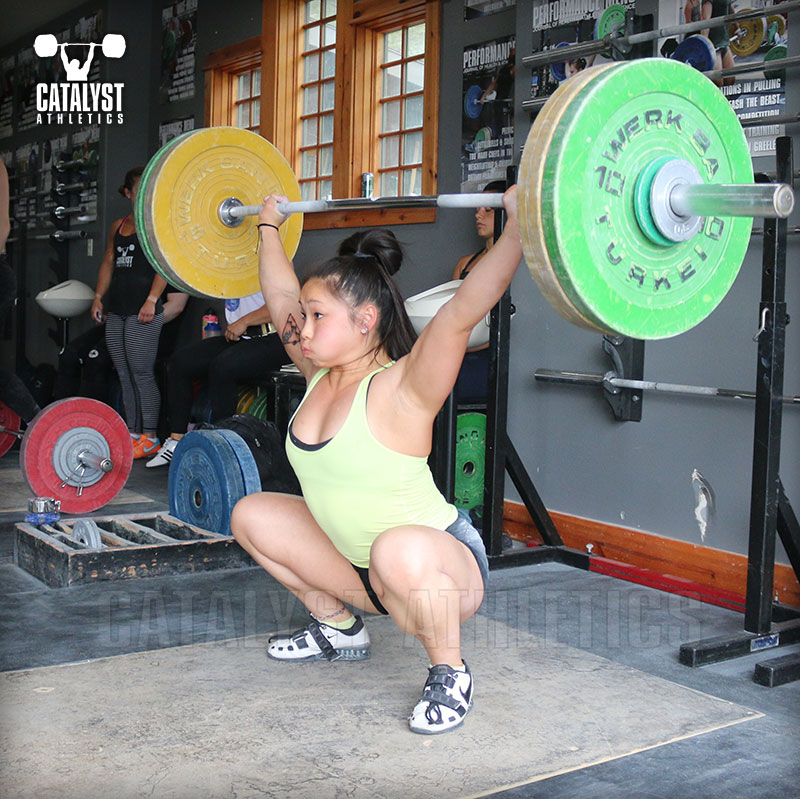Ask Greg: Issue 203

Stacey Asks: I started weightlifting a year ago and feel I’ve made good progress with my technique... but... I have a recurring problem in my snatch and my clean. There are times when I will receive my bar in the squat, but for some reason unknown to me, I sometimes end up falling forward onto my knees... I don’t end up dropping the bar though, I still have it overhead or in my rack position without fail even though I’ve landed onto my knees... I don’t know what is causing this... mobility, core strength... any ideas?
Greg Says: Most likely it’s the result of your feet moving backward as you pull under while the rest of your body and the bar remains in place. If you do remain in place, this is caused by incomplete and/or weak leg drive through the top of the pull—the feet will naturally sweep backward and onto the toes. It may also be that you’re moving forward due to imbalance at some point during the lift and your feet don’t move forward as much as you do, creating the same basic issue—your center of mass is in front of your base of support.
In any case, being able to hold onto the bar rather than dropping it forward suggests that the bulk of your body is in fact under the bar so the overhead position is secure and stable in that sense, and that you’re on the balls of the feet rather than flat-footed. If flat-footed, you’re more likely to simply be unable to support the bar overhead and forced to drop it; being up on the balls of the feet places the knees farther forward of that balance point, and that position allows the legs to more easily rock forward to bring the knees to the floor.
The solution is to focus on driving evenly through the whole foot in the pull, and to continue pushing against the floor with the legs for as long as you’re extending the hips.
You may also need to focus specifically on the way you move your feet initially to consciously work to replant them flat on the floor.
Greg Says: Most likely it’s the result of your feet moving backward as you pull under while the rest of your body and the bar remains in place. If you do remain in place, this is caused by incomplete and/or weak leg drive through the top of the pull—the feet will naturally sweep backward and onto the toes. It may also be that you’re moving forward due to imbalance at some point during the lift and your feet don’t move forward as much as you do, creating the same basic issue—your center of mass is in front of your base of support.
In any case, being able to hold onto the bar rather than dropping it forward suggests that the bulk of your body is in fact under the bar so the overhead position is secure and stable in that sense, and that you’re on the balls of the feet rather than flat-footed. If flat-footed, you’re more likely to simply be unable to support the bar overhead and forced to drop it; being up on the balls of the feet places the knees farther forward of that balance point, and that position allows the legs to more easily rock forward to bring the knees to the floor.
The solution is to focus on driving evenly through the whole foot in the pull, and to continue pushing against the floor with the legs for as long as you’re extending the hips.
You may also need to focus specifically on the way you move your feet initially to consciously work to replant them flat on the floor.
|
Greg Everett is the owner of Catalyst Athletics, publisher of The Performance Menu Journal and author of Olympic Weightlifting: A Complete Guide for Athletes & Coaches, Olympic Weightlifting for Sports, and The Portable Greg Everett, and is the writer, director, producer, editor, etc of the independent documentary American Weightlifting. Follow him on Facebook here. Greg Everett is the owner of Catalyst Athletics, publisher of The Performance Menu Journal and author of Olympic Weightlifting: A Complete Guide for Athletes & Coaches, Olympic Weightlifting for Sports, and The Portable Greg Everett, and is the writer, director, producer, editor, etc of the independent documentary American Weightlifting. Follow him on Facebook here. |
Search Articles
Article Categories
Sort by Author
Sort by Issue & Date
Article Categories
Sort by Author
Sort by Issue & Date

